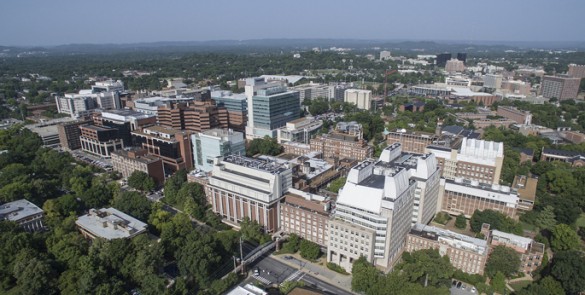
Effective April 30, Vanderbilt University Medical Center (VUMC) will be a fully independent, nonprofit entity following the completion of the transaction that separated it legally and financially from Vanderbilt University. The transition positions VUMC for future growth and investment, while preserving its tightly woven connections to the university in research and teaching.
“This is a remarkable moment in Vanderbilt’s history, and one that I believe will be marked as a time when Vanderbilt made a strategic and prescient choice that positioned both the university and the Medical Center for dramatic and sustained success,” Chancellor Nicholas S. Zeppos said. “Since Vanderbilt’s founding in 1873, we have time and again adapted and made investments always looking forward to address both opportunities and challenges. Today, we are once more evolving in support of our commitment to serve humanity through our noble mission.”
Jeff Balser, president and CEO of VUMC, will continue to serve as dean of the Vanderbilt University School of Medicine. His former title of vice chancellor for health affairs has been retired.
“We have taken care to assure VUMC is seamlessly connected to Vanderbilt University in fundamental ways, including a vast array of educational and research programs aimed at training the leaders of the future and driving innovation through discovery science,” Balser said.
Balser and Zeppos both serve on VUMC’s governing board, which was elected by the Vanderbilt Board of Trust in September.
The restructuring of the university and Medical Center began in November 2014 following a yearlong study by the Board of Trust in response to the rapidly changing health care economy. As a result of the restructuring, the university will have the ability to invest in its programs, spaces and people with focus and energy. As an independent entity, VUMC will be able to access the capital it needs to compete in the health marketplace. Its new flexible governance structure also will support the continued growth of the Vanderbilt Health Affiliated Network, which is the largest provider-organized network of doctors, regional health systems and other health care providers in Tennessee and surrounding states.
Teaching and research collaboration and connections between the university and the Medical Center remain a strategic priority for both institutions.
“Countless hours have gone into ensuring that the needed infrastructure, incentives and services are in place for our collaborations not only to continue, but also to thrive,” Provost and Vice Chancellor for Academic Affairs Susan R. Wente said.
Work will continue over the next several years to complete some of the information technology and other changes made necessary by the separation of the two institutions.
“For many, the standard modes of operation will go unchanged. Others may notice improvements, as we’ve taken the transition as an opportunity to update and improve our services when possible,” Wente said. “We will continue adapting, modifying and improving as Vanderbilt University and Vanderbilt University Medical Center move forward. As we do so, our students, staff and faculty remain our central priority.”
The development of the organizational structures, technology, processes and procedures needed to separate the university and Medical Center was carried out by 20 transition teams and involved a multitude of faculty and staff. The university was assisted by the Boston Consulting Group in developing the structure, and HoganLovells was lead outside counsel in the transaction.
“I extend my heartfelt thanks to Vanderbilt’s team of vice chancellors, other university leaders, faculty and staff, who devoted their expertise and time over the past 17 months to prepare both institutions for this day,” Zeppos said. “I deeply appreciate their thoughtful, thorough and responsible efforts.”
Information for university employees, as well as information about temporary outages of systems and services during recent and in coming days, are posted on the Transition website, vu.edu/transition.
Under the transaction, the Medical Center acquires its business and facilities from the university. The university retains the campus land on which Medical Center buildings are located. The university will use the bulk of the funds received from the transaction to pay down debt it has incurred related to the Medical Center and will use the remainder for other needs related to the university’s mission.
VUMC will correspond separately with its employees.















